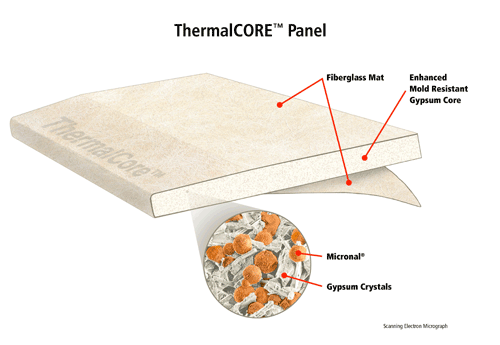I saw some sources that PCM enhanced gypsum boards has over 30 years history in US. I am not sure it is correct or not. They said the board was produced by immersion method which gypsum board is immersed in liquid PCM to absorb as much as possible of PCM. If so, we should have much valueable information on performance of PCM. However, I haven't seen any report on it. Do you have some information on it? Thanks a lot!
Blog Post
Storing Heat in Walls with Phase-Change Materials

I just returned from the Greenbuild conference in Phoenix. This annual event, now in its eighth year, has become the leading locus for exchange of information about the rapidly growing green building movement. This year's event drew some 22,000 attendees, including architects, builders, engineers, developers, and manufacturers, from the U.S., Canada, and dozens of other countries.
As is typical at Greenbuild, I spent a lot of my time in the trade show. While there were only a few hundred exhibitors at the first Greenbuild in Austin, Texas, this year's conference drew 1,800 exhibitors--so I had acres to cover. Indeed, there was lots of new stuff--despite the state of the economy and building industry. This week I'll focus on one of them: a phase-change wallboard, ThermalCORE, just announced by National Gypsum.
You might remember from high school chemistry that when materials change phase (from solid to liquid or liquid to gas) they absorb a lot of energy, and that energy is released when they revert to the lower energy state. If you add heat to a bucket of ice cubes at 0°F, for example, the temperature will rise steadily until it gets to 32°F; then it will remain at that temperature until all of the ice has melted, at which point the temperature of the water will rise again. (This is why we put ice in our drinks; it keeps the drink cool even as we add heat to it--from the room.)
This principle can be utilized with heat storage in a house if the melting point of the phase-change material is about room temperature.
Phase-change materials (PCMs) were first introduced in the 1970s. Most common were "eutectic salts" and specialized paraffins with melting points between 70° and 80°F. Some were housed in coffee-can-sized metal containers, others in plastic bags. None of these products stayed on the market long; after a few hundred cycles, they no longer melted or thawed completely over the narrow temperature range needed to make them effective for heat storage.
National Gypsum's ThermalCORE that was introduced at Greenbuild (but is not yet on the market) is a micro-encapsulated paraffin PCM. Tiny spheres of paraffin, just 5-10 microns in diameter (less than half the size of Portland cement particles), are encapsulated in acrylic shells, and these are mixed with the gypsum in drywall. The paraffin melts at 73°F, plus-or-minus 2°F. The PCM used in ThermalCORE is Micronal, made by the German chemical giant BASF. Micronal was introduced about five years ago, and BASF has been looking for a U.S. drywall manufacturer to partner with on a PCM wallboard.
SUPPORT INDEPENDENT SUSTAINABILITY REPORTING
BuildingGreen relies on our premium members, not on advertisers. Help make our work possible.
See membership options »BASF's Micronal PCM is available in commercial products in Europe, and it has gone through extensive testing. According to a BASF scientist I spoke with at Greenbuild, the material has been tested through 10,000 phase-change cycles (equivalent to 30 years of use) with no loss in performance.
National Gypsum's ThermalCORE has fiberglass skins (instead of paper), but otherwise looks no different than standard drywall; the micro-encapsulated PCM spheres are far too small to see.
Studies show that the ThermalCORE wallboard stores about 22 BTUs of thermal energy per square foot. The idea is that warmth from the sun during the day will be stored in the wallboard, and then released at night to keep the space warm. It will both help prevent overheating during the day and help reduce heating costs during the evening hours. In essence, it's a high-tech form of thermal-mass materials that are typically used in passive solar design (brick facing walls, tile floors, etc.).
Following the roll-out at Greenbuild, National Gypsum will begin field trials to determine how this product can most effectively be used in home building. Field trial sites are currently being sought through the California Emerging Technologies Coordinating Council and the U.S. Department of Energy National Renewable Energy Laboratory in Golden, Colorado; most will be in California.
National Gypsum has not said what the cost of ThermalCORE wallboard will be, or when it will be commercially available--except to say that it will not be introduced until after the field trials are complete. For more information, visit ThermalCORE's website. I've been following PCMs for thirty years now, and I think this is the first such product that has a chance of really succeeding--if the cost isn't too high. I look forward to tracking ThermalCORE's roll-out.
I invite you to share your comments on this blog. You can also follow my musings on Twitter.
Published November 23, 2009 Permalink Citation
(2009, November 23). Storing Heat in Walls with Phase-Change Materials. Retrieved from https://www.buildinggreen.com/blog/storing-heat-walls-phase-change-materials



Add new comment
To post a comment, you need to register for a BuildingGreen Basic membership (free) or login to your existing profile.